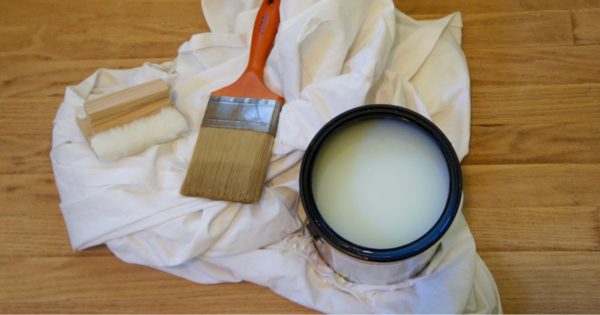How To Clean Polyurethane From a Brush?
After painting, it is necessary to follow the post-job cleanup process. Similarly, when you work with polyurethane, it is imperative to clean your brush after use. This way, you won't have to get yourself a new brush often, saving you money.
Learning how to clean polyurethane from a brush begins with knowing the types of polyurethane it has been exposed to.
To be short and quick, you should squeeze off the excess material as much as possible to clean polyurethane from your brush. Afterward, you must soak the brush into a paint thinner or a solvent for around 10-20 minutes for the polyurethane to come off entirely from the brush bristles.
This article will focus on cleaning a polyurethane brush after use, along with additional information regarding the maintenance of your polyurethane brush.
What Is Polyurethane?
Polyurethane is a coating applied on wood surfaces and furniture to keep them in their top shape and shine. It is a vital product used to maintain the freshness of wooden surfaces.
The material has a viscous consistency and is slightly challenging to handle. Once you apply the polyurethane to a surface and let it dry, you cannot turn it to liquid back again, even if you heat it.
However, the counterstory here is that it requires extra effort to clean a polyurethane brush, depending on the type of polyurethane used on the bristles.
What Are the Different Types of Polyurethane?

In terms of the complexity associated with cleaning a polyurethane brush, it is also necessary to learn about its different types. Hence, there are two types of polyurethane: water-based and oil-based polyurethane. Both types can dry instantly, which is an irreversible change as they cannot be turned into liquid form again on heating.
Water-based polyurethane
Water-based polyurethane is simple and easy to use than an oil-based one. It has a mild odor and is less toxic with an easy removing process. Furthermore, many prefer water-based polyurethane over oil-based since it retains the wood's natural shade and tone.
Oil-based polyurethane
Like oil-based paints, oil-based polyurethane is more durable than water-based but has a strong odor and toxicity. Even though it is much cheaper than water-based polyurethane, most people do not prefer using it, as its smell settles in the house, fabrics, and other things, which is very hard to get rid of.
What Products Should You Use To Clean Polyurethane From a Brush?
To clean polyurethane from brushes, paint thinners and solvents are the most-used materials. However, the cleaning agent entirely depends upon the type of polyurethane you used for your project.
An oil-based polyurethane can be cleaned using mineral spirits, whereas you can simply clean a water-based poly with a mixture of dish soap and warm water.
Here is a list of a few common solvents used to clean polyurethane from a brush:
Mineral Spirits
This solvent is mainly used to clean an oil-based polyurethane. Since oil-based polys require string solvents for the oils and chemicals from the polyurethane to be dissolved, mineral spirits serve as an excellent solvent for the latter. However, you must remember not to soak your natural bristle brush into a mineral spirit for too long, as it can weaken the brush bristles.
Soapy Water
You can use soapy water to clean water-based polyurethane. Since the base in water-based poly is water, it can quickly come off from the paintbrush when soaked for 10-20 minutes in a mixture of dish soap and warm or cold water. However, oil-based poly cannot be cleaned with soapy water, as water cannot dissolve the oil.
Acetone
Acetone is a natural and perhaps the most common paint thinner used to clean polyurethane from brushes. It is pretty effective in cleaning both types of polyurethane. However, you must remember not to soak your brush thoroughly in acetone, as it can soften the plastic from the paintbrush.
Therefore, use acetone just for wiping or cleaning the brush bristles. The rule of thumb says you can only soak your brush into acetone for not more than 30 seconds.
Other Types of Cleaning Agents
The following cleaning agents can also clean polyurethane from brushes:
- Denatured alcohol (For both types)
- Lacquer thinner (For oil-based poly)
- Warm water (For water-based poly)
- White spirits (For water-based poly)
- Turpentine (For oil-based poly)
How To Clean Polyurethane From Brush Bristles?
We have divided this section into two parts, according to the two types of polyurethane.
Cleaning the Water-Based Polyurethane
To clean water-based poly from brush bristles, wash your paintbrush under cold water and leave it to dry. Furthermore, you can also soak the brush in warm soapy water for around 10-20 minutes. Please note that it is not recommended to soak your polyurethane brush for too long, as it may weaken the natural bristles of the brush and shorten its lifespan. Wipe your brush with a dry cloth after washing, and store it in a cool, dry place.
Cleaning the Oil-Based Polyurethane
Oil-based polys require strong chemicals to be thoroughly cleaned. Therefore, paint thinners such as acetone and white spirits are quite powerful solvents, strong enough to remove the material from the brush even if it has dried. Soak your paintbrush for about 30-35 seconds in acetone or white spirit to soften the polyurethane on the bristles. Then wash it with soap and water with a few drops of mineral spirits to clean the leftover solvents from the brush.
How To Avoid Polyurethane From Drying on My Paintbrush?

If you are tired halfway through your project and want to call it a day, you absolutely can without worrying about the polyurethane form drying over your paintbrush overnight.
To prevent this from happening and keep your brush ready to use the next day, keep your polyurethane brush away from air exposure as much as possible. You can do this by keeping your brush in clean water or wrapping a cling film over it to keep the air at bay. It will also keep the brush bristles warm and moist, thus ready to be used the next day.
How To Clean a Polyurethane Brush With a Brush Comb?
Investing in paint or brush comb is worth it if you want to make your polyurethane brush cleaning easy and quick. A brush comb is a two-headed wire brush made of stainless steel pins on one side with brass bristles on the other. A brush comb can accelerate the process of cleaning polyurethane brushes, as you do not have to do much about cleaning the brush after removing the polyurethane from it.
But how does this brush comb works? The answer is simple. You just need to insert the brush comb into your polyurethane bristles and stroke downward for the product to come off the paintbrush gently.
You can then leave your paintbrush to dry in a jar, placing its bristles on the upward side to ensure that they dry first and do not attract molds and mildews due to excessive moisture.
Frequently Asked Questions
Can I use my polyurethane brush again?
Yes, a polyurethane brush can be used as many times as possible as long as the brush bristles are intact and are not falling off. The key to maintaining and reusing your polyurethane brush is to clean it right after you finish your project and store it appropriately.
Can I use a single brush for both water-based and oil-based polyurethane?
While using a single brush for both types of polyurethane is acceptable, you cannot achieve the desired finishing and results. So, it is best to use natural bristle brushes for oil-based polys and synthetic nylon brushes for water. But, as long as you clean your brush thoroughly, you can use it for both types.
How can I clean the polyurethane brush between multiple coats?
There are many ways to clean multiple coats of polyurethane with a paintbrush. The best one is to immerse your brush in hot water and soak it for a couple of minutes. You can then degrease the brush with denatured alcohol, lacquer thinner, or acetone.
Can I use vinegar to clean polyurethane?
Using vinegar to clean polyurethane from brush bristles depends on the types of polys and the quantity of vinegar used to clean the brush. You can use vinegar to clean only water-based polyurethane because oil-based polys require powerful solvents to be cleaned.
Final Thoughts
In conclusion, learning how to clean polyurethane from a brush is essential as it helps your brushes to remain in good condition for longer. You can find some tools to do this here.
However, cleaning your polyurethane brush after every coat and break is not always necessary. You can simply store your brush in water, or wrap it in a plastic film, and refrigerate it. This will keep the bristles moist, soft, and ready to use whenever you resume your project.
Last Updated on September 14, 2022 by Tom Bradly
